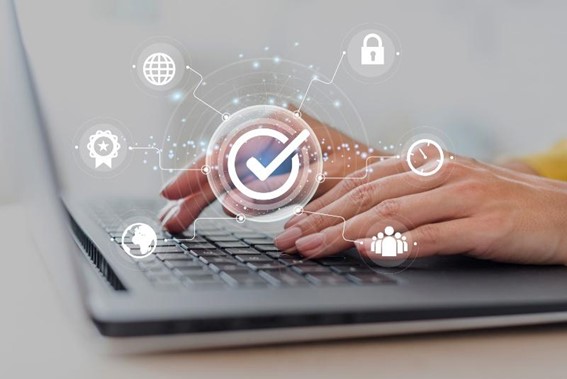Digitalization is becoming increasingly relevant in companies, highlighting their dependence on new technologies. This makes information security essential to prevent companies from leaving their data unprotected.
In this post, we explain what it consists of and provide 5 good practices in information security to start implementing.
What is information security?
Information security protects information and information systems against unauthorized access, use, disclosure, interruption, modification, or destruction. It has become a critical obligation for organizations.
Companies of all sizes and sectors handle a wealth of information, from personal and sensitive employee and customer data to financial and intellectual property information. This information is a valuable asset that, if compromised, can cause serious harm to data subjects and significant damage to an organization’s reputation and financial viability.
Therefore, organizations must establish procedures to ensure information security, protect against threats that may affect it, and ensure the continuity of their operations.
Procedures to Ensure Information Security
These procedures should include information security policies, access controls, information security training, security incident management, and disaster recovery and business continuity plans.
- Information security policies provide a framework for managing information security in an organization. These policies define employee responsibilities, security requirements for information systems, and procedures for handling security incidents.
- Access controls are measures that limit information access to authorized persons. These can include passwords, key cards, and two-factor authentication.
- Information security training is essential to ensure that all employees understand information security and their responsibilities regarding it. This training should cover topics such as the secure handling of information, identifying security threats, and responding to security incidents.
- Security incident management involves identifying, tracking, and resolving security incidents. These incidents typically include phishing attacks, data breaches, and different types of malware.
Disaster recovery and business continuity plans detail how an organization will respond to a security incident that results in a significant loss of information or operational capacity and nullify or minimize its effects.

Key Terms in Information Security
Three key terms allow us to understand the concept and constitute the characteristics of information security: confidentiality, integrity, and availability.
Confidentiality
It refers to the protection of information from disclosure to unauthorized parties. Confidentiality measures include data encryption, access control, and user authentication.
Integrity
In this case, it refers to protecting information against unauthorized modification or deletion. This ensures that the information is accurate and complete. Integrity measures include version control, backups, and intrusion detection systems.
Availability
It refers to ensuring that information and information systems are available for use when needed. Availability measures include system redundancy, disaster recovery, and business continuity planning.
These 3 characteristics of information security should guide organizations in the development of security policies, procedures and controls.
However, information security is not a one-size-fits-all solution that can be applied uniformly across organizations. Each organization must assess its own risks and develop an information security strategy that is tailored to its specific needs.
In addition, information security is not a static state, but an ongoing process. As threats and risks evolve, so do security measures. This requires constant vigilance, regular evaluation of safety policies and procedures, and ongoing user education and training.
5 Best Practices in Information Security
Among the best practices in information security, implementing these five in your company that we detail below is the starting point for any corporate information security procedure.
1. Security Updates
Security updates are critical to
protecting organizations’ information systems.
These updates contain patches that address the latest software vulnerabilities. Keeping systems up-to-date minimizes the risk of cyberattacks.
Discover the foremost common types of cyberattacks through our blog.
2. Access to information control
Access control is another crucial practice. It involves ensuring that only authorized individuals have access to sensitive information.
The organization should implement role-based access control policies to limit access to information based on its category and the job responsibilities of its employees.
3. Backups
Regular backups are essential for data recovery in the event of information loss.
The organization should make backups on a regular basis and store them in a safe place. In the event of a cyberattack, backups allow information to be restored and operational activity to be maintained.
4. Password management
Effective password management is vital for information cybersecurity.
It’s critical to encourage employees to use strong, unique passwords for each account, as well as to renew them regularly. Additionally, it is advisable to implement two-factor authentication to add an extra layer of security.

5. Staff Awareness
Finally, staff awareness is crucial in preventing the success of social engineering techniques. This is one cybersecurity tip that you should keep in mind.
Your employees need to be informed about cybersecurity best practices and how to identify potential threats. Regular training is critical for them to stay up-to-date on the latest threats and how to prevent them.
Kartos helps you protect the security of your company’s information
Kartos XTI Watchbots, our AI platform for Cyber Intelligence and Cybersecurity, enables your organization to proactively, continuously monitor key aspects of information security in real-time, such as:
- Passwords Leaked and Exposed
- Leaked and Exposed Databases
- Leaked and exposed documentation
- CVEs
- Outdated items
- Value Chain
Through monitoring of the Internet, the Dark Web, and the Deep Web, Kartos detects exposed security breaches affecting your organization’s information in real-time so that you can correct and nullify them before they are used to execute a cyberattack. Get to know our solutions!


